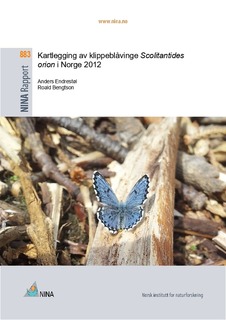Kartlegging av klippeblåvinge Scolitantides orion i Norge 2012
Research report

Åpne
Permanent lenke
http://hdl.handle.net/11250/2635269Utgivelsesdato
2012Metadata
Vis full innførselSamlinger
- NINA Rapport/NINA Report [2343]
Sammendrag
Endrestøl, A. og Bengtson, R. 2012. Kartlegging av klippeblåvinge Scolitantides orion i Norge 2012. NINA Rapport 883. Norsk institutt for naturforskning.
Klippeblåvinge Scolitantides orion (Pallas, 1771) ble varig vernet etter endring i forskrift om truede arter fastsatt av Miljøverndepartementet 6. februar 2008. I oktober 2010 ble et faglig grunnlag for en handlingsplan for klippeblåvinge publisert, og 18. februar 2010 ble handlingsplanen for klippeblåvinge lagt ut på offentlig høring. Den endelige handlingsplanen er fremdeles ikke sluttført. Klippeblåvinge er vedtatt prioritert med forskrift etter naturmangfoldloven 20. mai 2011. Arten er kategorisert som kritisk truet (CR) i Norge.
I 2012 har basisovervåkingen av populasjonene av klippeblåvinge i Halden og Tvedestrand blitt prioritert. Det vil si at vi har lagt vekt på søk etter, og telling av, egg på de to kjente lokalitetene. Vi har dessuten fortsatt å samle inn maur som besøker larver av klippeblåvinge, og i tillegg samlet inn et fåtall egg av klippeblåvinge for molekylære analyser. I tillegg ble det satt ut tre dataloggere for temperatur og fuktighet både i Halden og i Tvedestrand. Vi undersøkte dessuten et par ekstra lokaliteter i Risør kommune i 2012.
I Halden ble det funnet totalt rundt 325 egg av klippeblåvinge i området Torpbukta, men kun to på lokaliteten Nokkedal. I Tvedestrand ble det totalt funnet ett voksent individ og 42 egg av klippeblåvinge. Vi samlet inn maur fra fem av de åtte larvene av klippeblåvinge som ble observert i Torpbukta i 2012. Det ble samlet inn fire egg av klippeblåvinge fra Torpbukta i Halden, samt ett fra Tvedestrand med tanke på DNA-analyse.
I Halden har vi sett en stabil til økende trend for populasjonen av klippeblåvinge. At den tilsynelatende er økende kan imidlertid skyldes en del metodiske årsaker. Vi kan uansett i alle fall med rimelig sikkerhet si at populasjonen i Halden ikke er blitt mindre i løpet av de tre siste årene. Dette gir imidlertid neppe noen sikker grunn til å hevde at populasjonen er robust.
I Tvedestrand har vi sett relativt store svingninger i klippeblåvingepopulasjonen. I år (2012) fant vi minst 42 egg, og må sies å være et positivt resultat gitt de 10 som ble påvist i 2011.
I 2012 fant vi dessuten to ulike arter av maur innenfor slekten Myrmica på larver av klippeblåvinge. Vi har således funnet totalt fem arter av maur fordelt på tre slekter påvist på larver av arten i perioden 2010–2012.
Det kan konkluderes med at klippeblåvinge har en stabil populasjon i Halden, men at populasjonen i Tvedestrand fortsatt virker svært liten/ustabil. Sett under ett er situasjonen for klippe-blåvinge i Norge ikke god siden vi fremdeles kun har påvist arten i to kommuner, sammenlignet med historiske funn fra åtte kommuner. Endrestøl, A. & Bengtson, R. 2012. Mapping of the Chequered Blue Butterfly Scolitantides orion
in Norway 2012. NINA Report 883. Norwegian Institute for Nature Research.
The Chequered Blue Butterfly Scolitantides orion (Pallas, 1771) was protected after amendment of regulations on endangered species given by the Ministry of the Environment on 6 February 2008. In October 2010, a scientific basis for an action plan for the Chequered Blue Butterfly was published, and on 18 February 2010 the action plan was published and submitted to a public hearing. The Chequered Blue Butterfly was pronounced a «Prioritized Species» according to the «Biodiversity Act» i Norway on 20 May 2011. The species is categorized as critically endangered (CR) in Norway.
In 2012, the basic monitoring of the populations of the Chequered Blue Butterfly in Halden and Tvedestrand was given priority. That is, we have emphasized searching for, and counting, eggs at the two known sites. In addition, we have continued to collect ants from the Chequered Blue caterpillar. In addition collected we a few eggs from the Chequered Blue for molecular analysis. Three data loggers were set up for reading temperature and humidity in both Halden and Tvedestrand. We also surveyed a couple of additional sites in Risør municipality in 2012.
In Halden, a total of 325 eggs of the Chequered Blue Butterfly were found in the Torpbukta area, but only two at the Nokkedal site. In Tvedestrand, a total of one adult individual and 42 eggs were found. We collected ants from five of the eight caterpillars that were observed in Torp Bay in 2012. Four eggs of the Chequered Blue Butterfly were collected from Torpbukta in Halden and one from Tvedestrand, for DNA analysis.
In Halden we have seen a steady to growing trend for the population of the Chequered Blue Butterfly. However, the apparent increase may be due to a number of methodological reasons. In any case, we can say with reasonable certainty that the population in Halden has not de-creased during the last three years. However, this hardly provides any reliable reason for claiming that the population is robust.
In Tvedestrand we have experienced relatively large fluctuations in the population of the Chequered Blue Butterfly, and this year (2012) we found at least 42 eggs that must be said to be a positive result given the 10 that were detected in 2011.
In 2012, we also found two different species of ants within the genus Myrmica on caterpillars. We have therefore found a total of five species of ants from three genera on caterpillars of the species in the period 2010–2012.
It can be concluded that the Chequered Blue Butterfly have an acceptable population in Halden, whereas the population in Tvedestrand still seems very small / unstable. Nevertheless, the situation for the Chequered Blue Butterfly in Norway is critical since the species is found only in two municipalities, compared to historical findings from eight municipalities